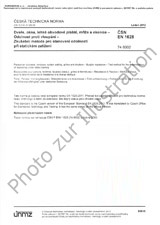Wir benötigen Ihre Einwilligung zur Verwendung der einzelnen Daten, damit Sie unter anderem Informationen zu Ihren Interessen einsehen können. Klicken Sie auf "OK", um Ihre Zustimmung zu erteilen.
ČSN ETSI EN 300338-1-V1.4.2 (875031)
Technical characteristics and methods of measurement for equipment for generation, transmission and reception of Digital Selective Calling (DSC) in the maritime MF, MF/HF and/or VHF mobile service; Part 1: Common requirements
Name übersetzen
NORM herausgegeben am 1.6.2018
Informationen über die Norm:
Bezeichnung normen: ČSN ETSI EN 300338-1-V1.4.2
Zeichen: 875031
Katalog-Nummer: 504374
Ausgabedatum normen: 1.6.2018
SKU: NS-848690
Zahl der Seiten: 48
Gewicht ca.: 144 g (0.32 Pfund)
Land: Tschechische technische Norm
Kategorie: Technische Normen ČSN
Kategorie - ähnliche Normen:
Receiving and transmitting equipmentNavigation and control equipment
Die Annotation des Normtextes ČSN ETSI EN 300338-1-V1.4.2 (875031):
V1.4.2
The present document states the minimum requirements for equipment to be used for generation, transmission and reception of Digital Selective Calling (DSC) for use on board ships.
DSC is intended to be used in the Medium Frequency (MF), High Frequency (HF) and Very High Frequency (VHF) bands of the Maritime Mobile Service (MMS), for distress, urgency and safety communication and general communications.
The present document is a multipart deliverable that covers the requirements to be fulfilled by:
- - DSC equipment integrated with a transmitter and/or a receiver;
- - DSC equipment not integrated with a transmitter and/or a receiver.
These requirements include the relevant provisions of the ITU Radio Regulations [i.17] and Recommendations ITU R M.493 14 [2], M.541 10 [3], M.689 3 [4] and M.1082-1 [5], the International Convention for the Safety Of Life At Sea (SOLAS) [i.16], and the relevant resolutions of the International Maritime Organization (IMO).
Equipment for generation, transmission and reception of DSC designed according to the following equipment classes:
- - Class A: includes all the facilities defined in annex 1 of Recommendation ITU R M.493 14 [2] and complies with the IMO Global Maritime Distress and Safety System (GMDSS) carriage requirements for MF/HF installations and/or VHF installations.
- Class B: provides minimum facilities for equipment on ships not required to use class A equipment and complies with the minimum IMO GMDSS carriage requirements for MF and/or VHF installations. This equipment should provide for:
- - alerting, acknowledgement and relay facilities for distress purposes;
- - calling and acknowledgement for general communication purposes; and
- - calling in connection with semi automatic/automatic services, as defined in Recommendation ITU R M.493 14 [2], annex 2, clause 3.
- - Class D: provides minimum facilities for VHF DSC distress, urgency and safety as well as routine calling and reception as recommended by IMO MSC/Circ.803 [i.2] for non-SOLAS vessels participating in the GMDSS.
- - Class E: provides minimum facilities for MF and/or HF DSC distress, urgency and safety as well as routine calling and reception as recommended by IMO MSC/Circ.803 [i.2] for non-SOLAS vessels participating in the GMDSS.
- - Class H: provides minimum facilities for handheld VHF DSC distress, urgency and safety as well as routine calling and reception as recommended by IMO MSC/Circ.803 [i.2] for non-SOLAS vessels participating in the GMDSS.
- - Class M: provides minimum facilities for VHF Man Overboard devices as defined in Recommendation ITU R M.493 14 [2].
NOTE 1: Class A and Class B equipment may support the optional semi-automatic/automatic service in accordance with Recommendations ITU R M.689 3 [4], M.1082-1 [5] and M.493-14 [2], tables 4.10.1 and 4.10.2 and are encouraged to do so.
NOTE 2: Class D and Class E equipment may also support the optional semi-automatic/automatic service
Normansicht ČSN ETSI EN 300338-1-V1.4.2 (875031)
Empfehlungen:
Aktualisierung der technischen Normen
Wollen Sie sich sicher sein, dass Sie nur die gültigen technischen Normen verwenden?
Wir bieten Ihnen eine Lösung, die Ihnen eine Monatsübersicht über die Aktualität der von Ihnen angewandten Normen sicher stellt.
Brauchen Sie mehr Informationen? Sehen Sie sich diese Seite an.




 Cookies
Cookies
